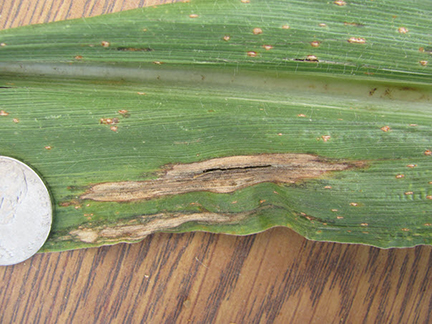The relatively cool weather Indiana has experienced this summer may be responsible for more observations of northern corn leaf blight (NCLB) on sweet corn than normal. The primary symptom is the cigar shaped lesion that ranges from 1 to 7 inches in length (see Figure 1). The lesions may range from tan to gray in color. Under conditions of high humidity, olive-green fungal spores may be produced on the lesion surface. Symptoms of NCLB are frequently observed late in the season when days become cooler. Yield losses are possible if lesions reach the ear leaf or higher during the two weeks before or after tasseling. NCLB can be managed by a combination of crop rotation, fall tillage, resistant hybrids and fungicide applications. Crop rotation and fall tillage help to minimize crop residue that might harbor the fungus that causes NCLB. Choose hybrids resistant to NCLB when possible. When it is necessary to use hybrids without resistance and weather conditions have been conducive to disease, fungicide may be used to help reduce symptoms of NCLB. See the Midwest Vegetable Production Guide for Commercial Growers for recommendations. Effective fungicides for NCLB include Headline®, Headline AMP® and Quilt XCEL®. Fungicides may be less effective if applied after tasseling.
This article was originally published on the veggiediseaseblog.org on August 25, 2015.
